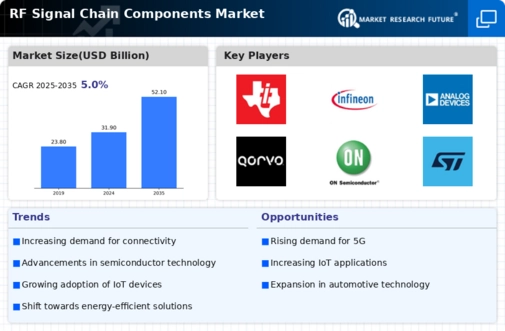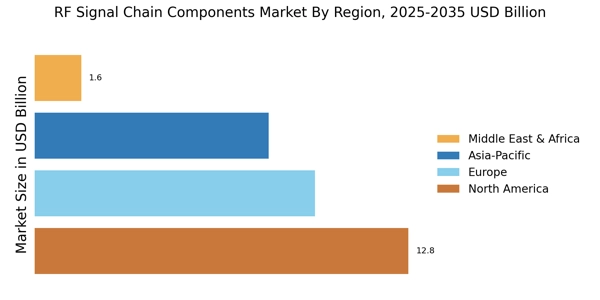Emergence of Smart Cities
The emergence of smart cities is a significant driver for the RF Signal Chain Components Market. As urban areas increasingly integrate technology to enhance infrastructure and services, the demand for efficient RF communication systems is on the rise. Smart city initiatives often rely on IoT devices, which require robust RF signal chains for data transmission and connectivity. Market analysis indicates that investments in smart city projects are expected to exceed 1 trillion dollars by 2025, creating substantial opportunities for RF component manufacturers. This trend is likely to spur innovation in RF technologies, as companies seek to develop solutions that can support the diverse needs of smart city applications, from traffic management to public safety. Consequently, the RF Signal Chain Components Market stands to gain from this growing focus on urban technological integration.
Growth of Automotive Electronics
The growth of automotive electronics is significantly influencing the RF Signal Chain Components Market. With the automotive sector increasingly adopting advanced technologies such as vehicle-to-everything (V2X) communication and autonomous driving systems, the demand for reliable RF signal chains has escalated. Recent statistics suggest that the automotive electronics market is expected to reach a valuation of over 400 billion dollars by 2026, with RF components playing a pivotal role in this transformation. As vehicles become more connected, the need for high-performance RF signal chains that can support various communication protocols becomes essential. This trend is prompting manufacturers to innovate and develop specialized RF components tailored for automotive applications, thereby driving growth within the RF Signal Chain Components Market.
Advancements in Semiconductor Technology
Advancements in semiconductor technology are playing a crucial role in shaping the RF Signal Chain Components Market. The development of new materials and fabrication techniques has led to the creation of more efficient and compact RF components. For instance, the introduction of gallium nitride (GaN) and silicon carbide (SiC) semiconductors has enabled higher power densities and improved thermal performance. This is particularly relevant in applications such as 5G networks, where the demand for high-frequency operation is paramount. Market data indicates that the semiconductor segment within the RF signal chain is expected to witness substantial growth, driven by these technological innovations. As a result, manufacturers are increasingly investing in research and development to enhance the performance and reliability of RF components, thereby propelling the RF Signal Chain Components Market forward.
Rising Demand for Wireless Communication
The increasing demand for wireless communication technologies is a primary driver of the RF Signal Chain Components Market. As more devices become interconnected, the need for efficient and reliable RF signal chains has surged. According to recent data, the wireless communication sector is projected to grow at a compound annual growth rate of approximately 10% over the next five years. This growth is largely attributed to the proliferation of smartphones, IoT devices, and smart home technologies, all of which rely heavily on robust RF signal chains. Consequently, manufacturers are focusing on developing advanced RF components that can support higher frequencies and bandwidths, thereby enhancing overall communication performance. The RF Signal Chain Components Market is thus positioned to benefit significantly from this trend, as companies strive to meet the escalating demands of consumers and businesses alike.
Increased Focus on Telecommunications Infrastructure
The increased focus on telecommunications infrastructure is a vital driver of the RF Signal Chain Components Market. As countries invest in upgrading their communication networks to support next-generation technologies, the demand for high-quality RF components is expected to rise. Recent reports indicate that global investments in telecommunications infrastructure are projected to reach over 300 billion dollars by 2025, primarily driven by the rollout of 5G networks. This expansion necessitates the deployment of advanced RF signal chains capable of handling higher frequencies and data rates. Consequently, manufacturers are prioritizing the development of innovative RF components that can meet these stringent requirements, thereby fostering growth within the RF Signal Chain Components Market. The ongoing evolution of telecommunications infrastructure is likely to create a favorable environment for RF component suppliers.
















Leave a Comment